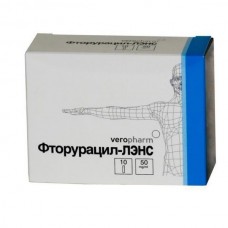Expiration date: 03/2026
Form release
Solution for intravascular and intracavitary administration
Composition
1 ml of solution contains 50 mg fluorouracil
Pharmacological action
Antitumor agent from the group of antimetabolites. Fluorouracil-LENS inhibits cell division by blocking DNA synthesis (due to inhibition of the enzyme thymidylate synthetase) and the formation of structurally imperfect RNA (due to the introduction of fluorouracil into its structure).
Indications
Skin cancer, colon cancer, rectal cancer, breast cancer, stomach cancer, liver cancer, uterine cancer, ovarian cancer, bladder cancer.
Contraindications
Peptic ulcer of the stomach and duodenum in the acute phase, bleeding of any localization, high risk of gastrointestinal bleeding, severe anemia, leukopenia, thrombocytopenia, pregnancy.
Dosage and administration
Fluorouracil-LENS is administered in / in a jet or drip, in / a (it is recommended to use an appropriate infusion pump to ensure a constant infusion rate), intracavitary. In/in the drip, any of the following schemes (administration is stopped when side effects - stomatitis, diarrhea, leukopenia or thrombocytopenia resume after the increase in the number of leukocytes up to 3-4 thousand/µl and platelets 80-100 thousand/µl): 1) 1 g/sq m/day/drip constantly during 96-120 h, 2) 600 mg/sq m/1 and 8 days of the course in combination with other drugs. When used in combination with calcium folinate fluorouracil dose is usually reduced by 25-30%, 3) 500 mg/m2 or 12-13.5 mg/kg daily for 3-5 days, the interval between courses - 4 weeks, 4) 600 mg/sq.m or 15 mg / kg (the highest single dose of 1 g) once a week for 6-10 weeks. When used in combination with calcium folinate fluorouracil dose is usually reduced by 25-30%.
Side effect
From the digestive system: decreased appetite, nausea, vomiting, heartburn, taste disorders, esophagitis, inflammation and ulceration of the gastrointestinal mucosa, ulcerative stomatitis, diarrhea, bleeding from the gastrointestinal tract, liver dysfunction. CCC: myocardial ischemia (angina, LV insufficiency, shortness of breath), which may occur within a few hours after administration, usually develops after the second or subsequent administration, myocardial infarction, thrombophlebitis at the site of administration. From the Central nervous system: acute cerebellar syndrome (ataxia, nystagmus), headache, disorientation, confusion, euphoria. From the hematopoietic organs: leukopenia (usually 9-14 days after each course, the lowest level of leukocytes is observed in 9-14, less often - 20 days, restored after about 30 days), neutropenia, anemia, thrombocytopenia. On the part of the senses: optic neuritis, lacrimation, lacrimal canal stenosis, visual impairment, photophobia, cataract, cortical blindness (at high doses). Allergic reactions: skin rash, dermatitis, urticaria, photosensitization, bronchospasm, anaphylactic shock. From the skin: hyperpigmentation of the skin, dryness and cracks of the skin, syndrome of palm-plantar erythrodysesthesia (tingling sensation in the hands and feet, followed by the appearance of pain, hyperemia and swelling), alopecia, telangiectasia, nail changes (including destruction). Other: azoospermia, amenorrhea, hyperuricemia, pneumopathy (cough, shortness of breath), epistaxis (nasal bleeding), weakness (usually occurs immediately after administration and persists for 12-36 h), the development of secondary infections.
Special instruction
When stomatitis or diarrhea appears, treatment with the drug should be stopped until these symptoms disappear. With the development of the syndrome of Palmar-plantar erythrodysesthesia, it is possible to prescribe pyridoxine inside at a dose of 100-150 mg/day. During treatment, it is necessary to control the total number of leukocytes and platelets, to determine hematocrit and Hb, the activity of AST, ALT, LDH, bilirubin, to examine the oral cavity of the patient for ulcers (before each drug administration). Patients with advanced lakopenia should carefully watch for signs of infection.
Drug interaction
Efficiency and / or toxicity increase other antitumor drugs (interferon alpha 2A, cyclophosphamide, vincristine, methotrexate, cisplatin, adriamycin), calcium folinate. Radiation therapy is an additive inhibition of the bone marrow. With long-term co-administration with mitomycin C, the appearance of hemolytic uremic syndrome was observed. While taking with sorivudine marked leukopenia, in some cases leading to death. Fluorouracil should not be used after and in conjunction with therapy with aminophenazone, phenylbutazone and sulfonamide. Chlordiazepoxid, disulfiram, griseofulvin, and isoniazid may increase the activity of fluorouracil. In connection with the suppression of natural protective mechanisms in the treatment of fluorouracil, it is possible to intensify the process of replication of the vaccine virus or reduce the production of antibodies in response to the introduction of the vaccine in vaccination with live or inactivated vaccines, so the interval between the end of the drug and vaccination with live or inactivated vaccines is from 3 to 12 months.
Storage conditions
In a dark place, at a temperature not exceeding 25°C.
Shelf life
2 years.


